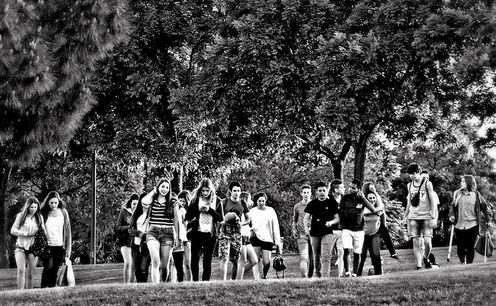
Adolescence is supposed to be the healthiest of times in our lives. But open any newspaper and you’re likely to find an article about the health problems of today’s youth. Whether it’s drugs or alcohol-fuelled violence, obesity, cyberbullying or sexting, you will most likely come away thinking this generation is in jeopardy. So what is going on?
There’s no doubt that adolescence is different today from earlier generations. For starters, it begins earlier because puberty has been on a downward trend for well over a century.
It also goes on much longer with pressures to stay in education, meaning transitions that have historically marked the end of adolescence now take place much later. And this has become the stay-at-home generation as most young people don’t have the financial means to move out of home when they want to.
Finally, for the most part, today’s adolescents will come to parenting in their thirties rather than their teens or twenties.
Risky years
One result of this is that the journey from childhood to adulthood is no longer just across the teen years but runs for a couple of decades. This means adolescence is now a bigger part of the life course than at any stage in human history.
So, what happens in these years matters more than ever.
That’s one of the reasons why youth unemployment matters. If a young person doesn’t make a successful transition to employment, the economic consequences for him or her, the next generation and the nation are profound.

Health is not all that different. These are the years that lay the foundations for health across the life course. It’s also when the parts of the brain that underpin mental health and emotional well-being are being shaped.
These are risky years when spur-of-the-moment decisions can have disastrous consequences. And they bring the highest risks for mental disorders and addiction.
It’s also during these years that young people acquire the emotional skills for parenting, to give the best possible start to life for the next generation. And given the complexity of life today as a young parent, this generation needs those capabilities more than any before.
A worrying picture
Given all this, the current signals about the health of adolescents, flagged in the Australian Institute of Health and Welfare’s in Australia’s Health 2014 report, are cause for concern.
Mental health problems such as depression, self-harm, anxiety and ADHD are at unprecedented levels. Alcohol and other addictions also remain at historically high levels.
The likelihood of 15 years of changing sexual partners before settling down with a life partner makes today’s adolescence and young adult years a time of high risk for acquiring sexually transmitted infections, such as chlamydia or herpes. And the emergence of new “hook-up apps” such as Grindr and Tinder pose further threats, even risking the return of the HIV threat in Australia.
While social networking and digital media have opened new opportunities, they also pose new risks, particularly for sexual and mental health.
And we now understand that the seeds of later life cancer and cardiovascular disease are laid in the problems of adolescent obesity, physical inactivity and a sedentary lifestyle, poor diet and substance abuse.

Marketing to young people is more intense than ever and is shaping health and lifestyles as never before. Families have also changed with the parents of today’s adolescents time-poor and uncertain about how to make the best investment in their children.
Erratic efforts
Our response to these shifts has so far been erratic; governments continue to have knee-jerk reactions to the health issue of the day.
Sometimes this has been around drugs, sometimes suicide and sometimes sexual health. Currently, it’s mental health. While this is undoubtedly an important matter, mental health needs solutions beyond psychiatric service delivery for already established problems. We need to begin to address the social and lifestyle shifts that have given rise to this modern epidemic.
The need for a coherent response is clear. But we’re moving further away than ever from doing this as policies in sectors central to health are being made without considering health.
Education is the biggest investment that governments make in adolescents. And we know investments in schools and higher education institutions, particularly in social, physical and cultural environments, have far-reaching effects for both academic achievement and health.
But policies in health and education are rarely linked and health remains a neglected appendage, despite the lessons about its links to learning. The same remains true of investment in families, communities, protective care and justice systems.
Moving forward will require us to step back and see the bigger picture of adolescent health and well-being. Yet, even here we struggle; Australia is one of only two countries in the OECD that doesn’t collect information on adolescent health that would allow us to compare how our youth are travelling compared to those in similar countries.
At a time when governments around the globe are recognising more than ever that future prosperity depends on the health and well-being of today’s adolescents, we are, sadly, less prepared than ever to meet the challenge.
This is the last piece in The Conversation’s Another Country: Youth in Australia series. See the rest of the series here.
George Patton receives funding from the National Health and Medical Research Council (NH&MRC) and the Australian Research Council (ARC).
Susan Sawyer receives funding from NHMRC.
